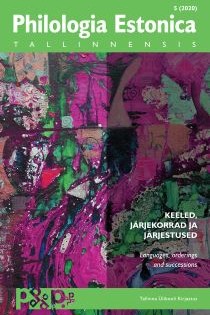Explaining the emergence order of contact-induced language change phenomena in language maintenance [Seletades kontaktidest johtuvate muutuste tekkimise järjekorda]

Abstract
According to generalizations made by Thomason and Kaufman (1988), contact-induced language change in language maintenance starts from the lexicon, then progresses to semantics, phonology, non-core morphosyntax and may result in a profound restructuring. To date no explanations for this particular order have been suggested. The article “translates” the borrowing scale into the metalanguage of the code-copying framework (Johanson 1992), which views contact-induced language change in lexicon, meaning and structure within the same terminological framework. This terminology enables the view that the cognitive mechanism is the same (copying), only that different types of meaning (specific vs. abstract) produce different types of copies. Specific or expressive items yield global copying, while more abstract meaning (grammatical) yields selective copying. Apparently, processing, entrenchment and conventionalization of more abstract meaning require more time than in the case of specific or expressive meaning. This explains why structural changes (selective copies) appear later.
Keywords
contact-induced language change, code-copying, structural change, Estonian, Russian, English